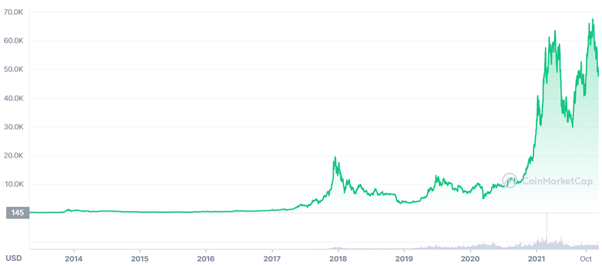Cryptocurrency Bubble Risks Exposed By Recent Bitcoin Slide
They seem to be almost everywhere. Cool hipsters who live the dream after amassing a fortune in the crypto world.
Social networking sites are full of them. Even the old-school glossy magazines, which barely cling to life, wrote big and less true stories about the fabulous riches to be earned in the ether.
There is no doubt that they exist. Those who entered early or built financial structures that facilitate trade that no one likes to admit replicate old-fashioned banks and brokerage houses have swallowed up unimaginable wealth.
But what about the hoi polloi? How many newly arrived crypto traders, for example, lost their savings last weekend when bitcoin and the crypto universe collapsed?
Just like pokie junkies and those who frequent the track, victories are brought up while losses are often forgotten.
The appeal can be the same; the chance to get rich, big time. But, unlike regular gamers, many crypto enthusiasts have embraced what they believe to be the future of finance with a sort of religious fanaticism that isolates them from reality.
Launched in 2009, Bitcoin was supposed to free ordinary citizens from the shackles of government and the nation; an alternative, independent and truly global financial system.
More than a decade later, however, and the devotees cannot or refuse to recognize the ultimate irony. Instead of overthrowing traditional currencies, bitcoin and its roughly 10,000 imitators are still valued there.
The devotees, even the most famous and fabulously rich, measure their wealth not in BTC but in greenbacks, yen, pounds, euros and Australian dollars.
Money, money, honey
We all want it. We all need it. But few really know how it really works.
Money, even the good old bills and coins, is a complex and little understood phenomenon that relies on faith; that it is backed by real wealth and that it will be redeemed. Even then, there are competing theories as to how it works, how it is created, and how it is controlled and manipulated.
Basically, it is a means of exchange. And it’s usually backed up, either by a government’s implicit promise or some other store of wealth, like gold.
Bitcoin was supposed to provide an alternative; an island of stability in a sea of âânational fiat currencies that have been degraded and diluted by governments, a system rocked by regular financial crises.
Instead, bitcoin has become almost useless as a medium of exchange, given that it is expensive and slow to transact.
But it was the extreme volatility that made it truly unusable. A car dealer who accepted Bitcoin at US $ 68,000 a fortnight ago reportedly ended up suffering a colossal loss last week.
And if there’s one thing the pandemic has proven, it’s that it has become a purely speculative, high-risk toy.
Rather than a safe haven, which should appreciate in times of crisis, cryptocurrencies are accentuating the economic wave.
Bitcoin bubble

They soar in good times and crumble at the slightest sign of trouble. Over the past year, that volatility has hit steroids, turning cryptocurrencies into a volatile and potentially deadly investment.
As the price chart above shows, the global stock and real estate markets – both of which have swelled wildly as interest rates have been brought down to zero – have been relatively tame by comparison.
It grabbed the adaptive and started it up. Wall Street thrives on volatility, and over the past year, global investment banks and fund managers have started to enter the crypto world. Even retail banks like the Commonwealth Bank have opened the door for customers to take a punt.
But when banks of computers and algorithms enter the trading equation, the chances of small players trading their way to fame quickly diminish.
How central banks are about to eat crypto lunch
Reserve Bank of Australia Governor Phil Lowe is about as far removed from the grunge crypto world as possible.

For years, a crypto critic, the RBA, like many major central banks, has nonetheless explored ways to apply blockchain technology behind cryptocurrencies for use in its own operations.
Millions of Australians now regularly use digital wallets on their smartphones and, in a speech last Wednesday, Dr Lowe described several possible scenarios in which the RBA could issue and save digital ‘tokens’ similar to Bitcoin and d ‘other cryptocurrencies, in the same way it issues. Bank notes. But even that was a long way, given our âefficient, fast and convenient electronic payment systemâ.
That was not all. He then bazooka the cryptocurrency team when he blurted out that the bank was open to allowing private players to issue an electronic dollar linked to the Australian dollar for retail users.
But if that happened, it would have to be backed by high quality assets as a bond.
“So if stablecoins issued by the private sector are ultimately the way things are, it will be crucial that they meet very high standards,” he said.

This is where the biggest threat to the crypto team lies. Having failed to take control of global finance, cryptocurrencies as they stand today could find themselves obsolete as the world’s largest central banks turn the tide and launch their own digital currencies.
Digital currencies may be the “inevitable future of money,” as one big crypto investor puts it, but there’s a good chance they’ll be ruled by the same central bank overlords who currently run global finance.
All currencies or private tokens will find themselves heavily regulated and forced to follow the rules.
The dangers of the crypto bubble
For the second time in as many months, an Australia-based crypto exchange, MyCryptoWallet, collapsed last week, leaving 20,000 investors stranded and likely losing everything. BlockChainGlobal went bankrupt in October for $ 23 million.
Almost completely unregulated, investors use these exchanges to trade cryptocurrencies and generally leave their investment on the exchange for safekeeping. The alternative is to keep it yourself on a hard drive or some other form of technology that may fail, be lost, or forgotten.
All the value of cryptocurrencies has now exceeded $ 3 trillion.
That doesn’t include the infamous world of NFTs, non-fungible tokens, on everything from art to fantasy real estate and cattle. You can even put your imaginary paddocks on imaginary agist horses for decent returns!
If everything collapses, the losses will be anything but imaginary.
No wonder central banks and governments are nervous and belatedly trying to curb the whole phenomenon. More than 20 countries, including China, have banned bitcoin and many others, including Australia, seek to impose regulations.
In the event of a serious collapse in the value of these markets, there could be serious economic consequences in the real world. But, since they spin freely outside the system, there is no safety mechanism or potential for rescue.
The specter of rising interest rates sending high-risk asset markets shuddering, an upheaval in these overvalued, overvalued and overweighted markets seems almost certain.
And the repercussions could be much more serious than expected.